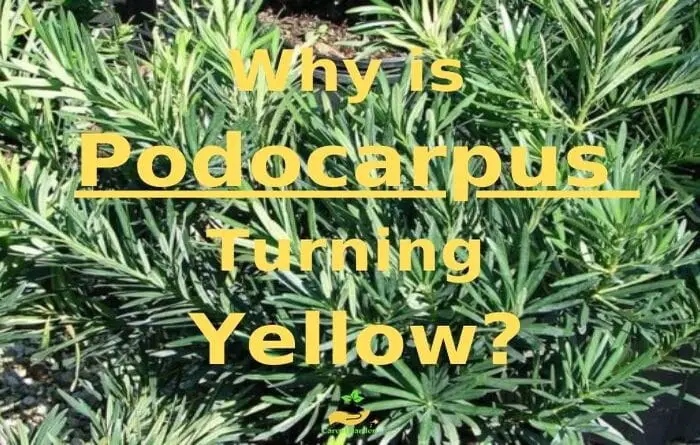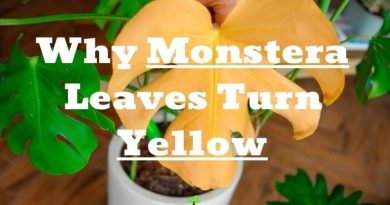Why is Podocarpus Turning Yellow? (5 Reasons & Solutions)
Podocarpus is a beautiful type of coniferous tree and one of the most popular hedge plants used to decorate parks, suburban areas and streets. The biggest problem with podocarpus is the fact that it turns yellow and in this post we will find out the reasons why podocarpus is turning yellow and how to prevent this from happening!
Yellowing of podocarpus leaves is caused by several factors including: excess watering, lack of water, environmental stress, unsuitable soil, lack of sunlight and diseases and pests.
| Reasons Podocarpus is Turning Yellow |
|---|
| 1.Improper watering |
| 2.Environmental Stress |
| 3.Lack of sunlight |
| 4.Nutrient deficiency |
| 5.Pests and diseases |
1.Improper watering
Improper watering(overwatering or lack of water) is the main cause why podocarpus leaves are turning yellow. Prolonged drought and lack of moisture are harmful to podocarpus plants in the same way excessive watering is.
In the case of podocarpus, water must always be perfectly balanced, neither excessive nor lacking, and of course it is not possible to establish a predefined quantity of water a priori, because it depends on numerous factors: size of the plant (in this case tree plants whose trunks are intertwined), size of the pot, room temperature, sun / shade, ambient humidity.
Overwatering
Overwatering is one of the most common problems that can lead to yellowing of podocarpus tree leaves. It blocks oxygen in the soil and determines an accumulation of moisture, which results in rotting of the podocarpus root system causing the leaves to turn yellow.
To prevent overwatering, it is recommended to check the state of the soil: if the soil is moist do not water the podocarpus and wait until the surface of the soil is dry enough before watering.
Podocarpus does not need to be watered every day and it is also very important to use warm water.
The soil should be checked before watering. It should not be wet at a depth of 10 cm. On hot days in the evening, the podocarpus is watered with irrigation.
Lack of water
Lack of water or exposure to drought causes the leaves to yellow and wither at the top of the podocarpus tree before spreading out and covering all the foliage. Also lack of watering dries out the tree roots, cutting off the supply of nutrients to the tree.
Insufficient watering also increases the stress on the podocarpus, especially during dry periods with prolonged exposure to sunlight, which causes the leaves to turn yellow.
To prevent lack of water, try to increase the frequency of watering. As soon as the soil is dry to the touch, water thoroughly, enough so that the excess water drains. After 3 or 4 days check the soil again and if is dry water it again, otherwise don’t water.
2.Environmental Stress
Podocarpus is susceptible to environmental stress factors like: improper soil, dry wind, air pollution, soil pollution and transplant shock. A combination of these environmental stress factors can cause podocarpus leaves to turn yellow.
Transplant shock
Newly planted podocarpus tress are turning yellow most likely by transplant shock, which is caused by the loss of some of the roots, planted in new soil and can last a year or two.
Planting podocarpus during hot weather instead of autumn or winter can cause the needles to turn yellow first, and then turn completely brown.
Transplant shock can cause leaves to turn yellow, even if the tree is properly planted. Improper planting practices, such as planting the tree too deep or not enough water until the plant is established, can turn evergreen pines into yellow pines.
Transplantation shock is triggered by the loss and damage of their roots, which severely limits the water supply to the needles. The consequences of this process are successive yellow discolorations from the needle tips, which ultimately lead to the leaves dropping.
Dry wind
Pines species like podocarpus are susceptible to wind damage. After a strong storm, the leaves may turn yellow, and some trees may eventually die.
Podocarpus can react to sudden temperature fluctuations created by wind, especially in autumn. It can be injured, which eventually turn the leaves yellow.
To treat this problem do not fertilize the tree for a while and protect it from temperature fluctuations.
Soil pollution
This can happen if podocarpus trees grow near the road, or the soil is contaminated with animal urine. Road salt that gets on pine trees can burn plant tissue, causing the needles to turn yellow.
To solve the problem, sanitary pruning is carried out, and the plant is watered abundantly so that the salts go deeper into the ground.
Improper soil
Clay, heavy soils do not allow the roots to receive oxygen and inhibit their development. Moisture does not linger in the sandy soil and quickly seeps down and the podocarpus does not receive enough water.
When planting podocarpus in peat soil in low areas where there is stagnant water, the root system begins to rot, the tree dries and dies. To avoid such a situation, the soil mixture is selected light and nutritious, consisting of soil, peat and sand in a ratio.
Is your dianthus flower dying? Don’t worry because I know how you can save them!
3.Lack of sunlight
Many people mistakenly think that all plants love the bright sun. Just the same, most plants require shading. Podocarpus does not like a bright place too much, but it will grow poorly in the shade.
When podocarpus does not receive enough sunlight it will not produce chlorophyll and as a result the leaves start turning yellow.
To treat the lack of sunlight you should check if the tree is too shaded and it is missing the necessary sunlight and move it to a place where it will receive at least a few hours of sunlight a day.
4.Nutrient deficiency
All plants need water and nutrients, but individual needs vary by tree species. A number of nutrient deficiencies can cause podocarpus leaves to turn yellow.
The lack of mineral fertilizers is easy to recognize: if you do not feed the plant, there is not enough nutrition.
| Nutrient Deficiency | Symptoms on Podocarpus Leaves | Treatment |
|---|---|---|
| Nitrogen | Older leaves turn yellow, while newer leaves remain green. | Apply nitrogen-rich fertilizer and ensure proper watering and drainage. |
| Iron | Leaves turn yellow between the veins, while the veins themselves remain green. | Apply iron chelate or iron sulfate to the soil or as a foliar spray. |
| Magnesium | Yellowing starts at the leaf margin and moves inward, while the veins remain green. | Apply magnesium sulfate (Epsom salt) or dolomitic lime to the soil. |
| Zinc | Yellowing between veins, with browning of leaf edges. | Apply zinc sulfate to the soil. |
| Manganese | Yellowing between veins, with brown spots and dead areas. | Apply manganese sulfate to the soil. |
| Potassium | Yellowing of leaf margins, with browning and curling of leaves. | Apply potassium-rich fertilizer, such as wood ash or potassium sulfate. |
Lack of Nitrogen
With a nitrogen deficiency in the soil, the podocarpus turns yellow, slows down growth and becomes weak and frail. To replenish nitrogen, ammonium sulfate or nitrate is introduced into the soil.
Do not forget that nitrogen-containing fertilizers should be applied in the spring, as a last resort, in the summer.
Lack of Iron
A lack of iron in the soil can also cause yellowing of the leaves. Often, iron deficiency can be observed after the liming procedure or when the soil is highly acidic.
Chlorosis is a change in the color of the leaf plate determined by a lack of iron. The most striking sign of chlorosis is the yellowing of the lower and upper leaves, while the leaf plate does not change color completely: either the veins turn yellow, and the leaf itself remains green, or vice versa.
You can treat nutrient deficiency with the following measures :
- Treat acute chlorosis with fertilizers containing iron chelates.
- Use only special complex compositions intended for conifers or acidic leaf compost.
- Do not fertilize podocarpus with fresh manure.
- Alternatively fertilization with Epsom salt.
- Water podocarpus exclusively with rainwater or decalcified tap water.
5. Pests and diseases
Phytophthora root rot
Phytophthora root rot is one of the most common fungi that attacks the podocarpus. Root rot destroys the young root system, causing the podocarpus to turn yellow and then die within one season.
In fact, this fungus begins by attacking the roots which absorb water and nutrients from the soil. Despite watering, they cannot feed the plant and, for this reason, the foliage begins to turn yellow. In turn, we identify the symptom as a lack of water and, by continuing to irrigate, we further aggravate the problem.
Symptoms are usually the drying of the branches which progress, starting from the base and rising little by little. Yellowish spots appear on the leaves , which eventually dry up and widen over time.
Treatment
Preventive spraying with Bordeaux liquid twice a year will prevent the occurrence of phytophthora root rot. Podocarpus trees are treated by removing the affected branches and lubricating the leaves with copper sulfate.
It is important to specify from the beginning that the yellowed parts cannot be recovered. What we can do now, however, is to curb the process, using an appropriate fungicide , applied according to the manufacturer’s doses.
Spider Mites
If your evergreen turns yellow in the spring, several pests that feed on pine needles could be the culprit: mites. These are small insects of white or red color, after their appearance, thin cobwebs form on the leaves.
As their feeding progresses, symptoms include twisting and yellowing of the podocarpus leaves.
Podocarpus is quite resistant to pest damage, but nevertheless, with increased dryness of the air, it can be affected by spider mites.
| Podocarpus Pests | How to treat |
|---|---|
| 1. Spider mites | Cut and burn the damaged branches, spray the podocarpus with pesticides |
| 2. Scale insects | Apply caterpillar glue rings on the podocarpus trunk. |
| 3. Aphids | Apply pesticides on the leaves. |
How to prevent Podocarpus leaves from turning yellow
In a garden
- Plant your podocarp in your garden in fertile, well-drained soil.
- Plant your podocarpus in a sunny or partially sunny spot. If this is not possible, yew pine can also tolerate shade. Pine yew is a hardy plant. You can even plant it in coastal areas, because it is tolerant of salt spray from the ocean.
- Choose an area that is large enough to accommodate an adult podocarpus. They can grow up to 50 feet (15.2 meters) tall with a spread of up to 25 feet (7.6 meters).
- Plant your podocarp in a moderate climate. The podocarpus plant prefers temperatures between 61 and 68 degrees Fahrenheit (16 to 20 degrees Celsius) and should not be grown anywhere the temperature drops below 55 degrees Fahrenheit (12 degrees Celsius).
- If outside temperatures are not conducive to podocarp growth, you can do so in a well-lit spot indoors.
In a pot
- Use a container that has a drainage hole(s) and a quality potting soil or potting mix, or a 50/50 combination thereof.
- You can also add 10-20% pumice or perlite to the soil mix to improve drainage.
- Also be sure to choose a container that is large enough to allow for 2-3 years’ growth before upgrading to a larger container. This could mean that your pot would be 6 to 8 inches or more wide than the root ball of your plant.
- To remove your podocarpus from the nursery container, start squeezing the sides of the tube to loosen the root ball. Then try to gently remove the plant from the container.
- If the root ball is stuck, it is better to use scissors or a knife to cut the container. After you have removed the plant from the container, loosen some feeder roots around the sides and bottom surfaces of the root ball.
- Podocarps are not heavy feeders, however they will benefit from fertilization. To avoid stimulating new growth that could be damaged by an early frost, stop fertilizing two months before the first frost date in your area.
Can podocarpus yellow leaves turn green again?
Once the podocarpus leaves have turned yellow, they are typically dead or dying, and it is unlikely for them to turn green again. Yellow leaves can indicate a problem with the podocarpus tree, such as a nutrient deficiency, root damage, or environmental stress. However, if the underlying problem causing the yellowing is addressed, new green leaves will grow.
The main causes of yellow leaves on podocarpus are waterlogging, lack of water, nutrient deficiency, soil pollution, diseases, pests and lack of sunlight.
Podocarpus can suffer from root rot if the soil is kept too moist. This could be if you’ve been watering more than once a week, or if they’re next to a lawn or flower bed that gets watered frequently.
If the roots are dead or dying off, prune the most visibly affected roots and repot your tree after adding organic matter to the soil so it drains faster.
Then repot the tree and water it well to help it settle into its new home.




